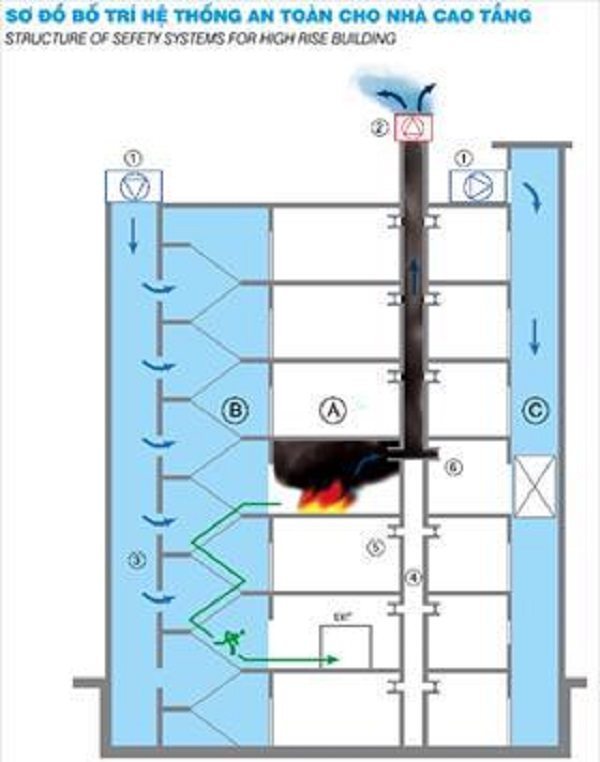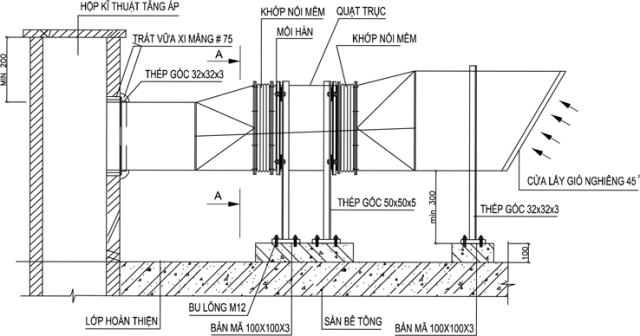PRINCIPLES OF OPERATING CONTROL OF CIRCUIT BRIDGE
Updated: 20-08-2019 | Hits: 185
Devices for a booster system include: booster fans, wind pipes, supply doors, open and close valves, sensors, power supply and control cabinets.
Each function of these devices aims to prevent smoke and fire from entering the stairs, so the pressure column in the staircase must be higher than in the corridor. Therefore, there must be a fan to create high pressure to supply air to the stairs.
According to Vietnamese standards: when creating the difference between the emergency staircase and the outer hall, it must be greater than 20Pa. For the purpose of a fire incident, smoke cannot be gathered in the emergency ladder cage. To facilitate the escape.
Technical requirements:
- Pressure level: When all entrance doors are closed, the wind level must be sufficient to maintain the following pressure difference: Specified area Pressure difference to be maintained The entire staircase 50 Pa 10%
- This system is applied to the emergency ladder, the pressure will be made by centrifugal fan placed on the roof. This fan will supply pressurized air through the pressurized gene, distributed to each floor by the wind mouth.
- Air discharge velocity is 0.75 m / s when the emergency staircase door is opened simultaneously at the adjacent floor, the last two doors on the ground floor are open and all the remaining gates of the pressure ladder at all levels Other are closed.
- The opening force is not greater than 110N All power and control cables must use fire-resistant cables.
- The power supply to the pressurized fan will be the preferred source.
- The pressure regulator area should provide a ventilation outlet to avoid overvoltage.
- The operation of all pressurized systems will be directly controlled from automatic fire alarms whenever there is a "fire" signal from the fire alarm center. Emergency button to start pressurized system is installed no more than 1m from the entrance to the stairs, outside the ladder. The system must not stop unless there is manual shutdown mode.
- Each system will be provided with an on / off control switch in the main fire control cabinet.

1. The main objectives of the pressurization system
The goal of any pressurized system is to keep smoke and poison gas away from the emergency exit so that people in that fire zone can escape or find a safe haven.
a) Human safety: Protect human life in cases of fire by emergency exits or pressurized temporary shelters.
b) Fire-proof: In order for fire-fighting operations to be effective, the elevator or stairway axes need to be maintained at different pressure to prevent the penetration of smoke from the burnt floor when the floor is burnt or not. no air conditioning system.
c) Property protection: The spread of smoke into areas where valuable equipment, data processing facilities and other equipment are particularly sensitive when smoke or damage is required is limited.

2. Principles of stair booster system
Stair pressure boosting systems in buildings include fans, wind pipes, supply gates, collapsible valves, sensors, power supply and control cabinets.
The function of this system is to allow smoke and fire not to enter the staircase, the pressure column in the staircase must be higher in the corridor. Therefore, there must be a fan to create high pressure to supply air to the stairs. People (weak and strong) can push the door to enter the stairs (this door is never locked). Stair doors are fireproof doors (heat-resistant and fire-resistant for about 1 or 2 hours) that will have hydraulic hinges that automatically close and partly due to pressure in the strong ladder that will close continuously.
3. Control
The process of controlling the turbocharger fan is when the smoke or fire burns, the smoke sensors transfer the signal to the central fire alarm system to close the electrical contact for the fan to run, pressurize the stairs. Pressure differential sensors in the stairs will cause the fan to run continuously or stop (pressure difference is set so that the pressure in the staircase is always greater than the pressure outside the staircase.) And not to install overcurrent protection device or anti-short circuit for this fan.
4. Operation
The fan presses air into the stairs and the air escapes the burning area including smoke and dust. When a person runs out of a door on the first floor, for example, the door will open and there is a hydraulic hinge that pulls the door always closed, and the door system to release part of the dust (if it gets caught in the stairway) then it goes out. on the other hand, this door has a regulating valve and a differential pressure sensor, which only opens when the pressure is within the allowable limit.

When a fire occurs from a room (apartment), smoke will spread to the hallway, so there must be a smoke control exhaust system used to minimize the effects of smoke. This system consists of smoke valves (always closed) under the ceiling of each floor connected to suction pipes to the exhaust fan placed on the roof. When there is a fire alarm signal, the smoke valve at the floor is burnt and the exhaust fan is activated to open the smoke. The chimney must be at least 2.5m above the roof top. Heat-resistant fan.
According to foreign standards: Closed emergency staircases (not required for open staircases) need to be pressurized 20 - 50 Pa so that smoke cannot penetrate the stairs (TCVN is 20 Pa), in case People are evacuated through the buffer room, the wind speed through the door is 0.75 - 1.3 m / s. The number of open doors is usually 1 door on the ground floor (emergency exit) and 1 door on the burnt floor. Compartment for elevator system including normal elevator and fire lift and rescue ladder ... operating during the fire must also be applied as a staircase. The air supplied to the staircase and elevator can be from one or more fans, blown straight up the stairs or through the air supply hose.
How to calculate pipeline resistance and select fans according to the usual calculation methods.











